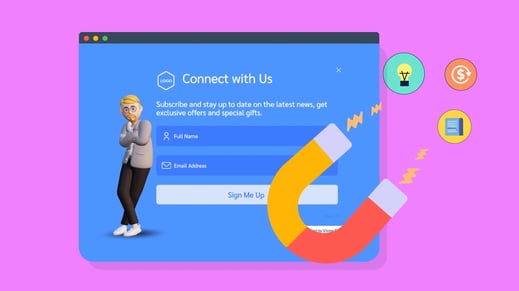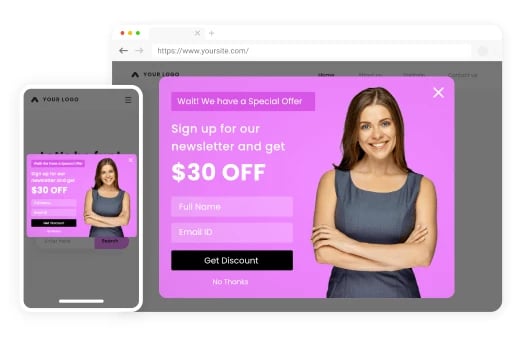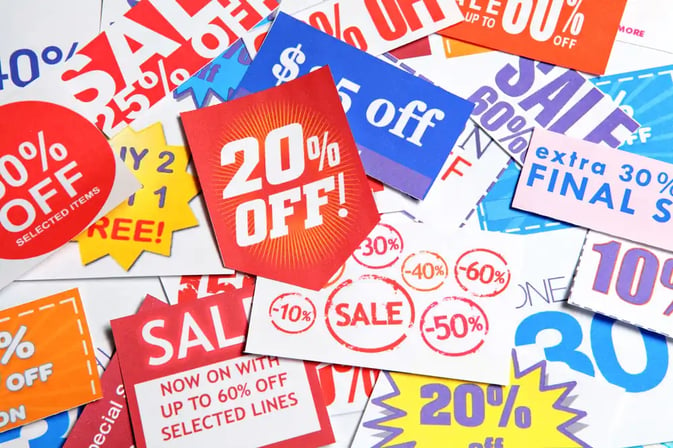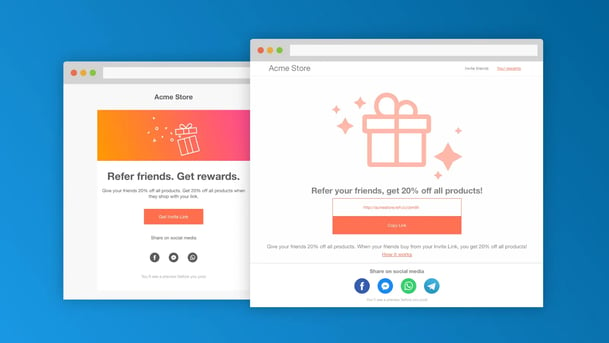Discover The Top 10 Lead Generation Strategies For Your Store
A visitor, a LEAD, and a paying customer. What is the difference?
Imagine a painter who creates masterpieces but displays them in an atelier no one visits. What a waste of the paintings, right? In that scenario, the problem is that the atelier doesn’t even get visitors. Now, imagine another scenario where people visit and view the paintings but do not fill in the forms distributed by the atelier to collect their phone numbers to inform them of future exhibitions. The problem here is not about not having visitors anymore but about not having LEADS. A third scenario is when the atelier gets visitors who provide their contact information, become leads, and receive the atelier’s news based on which they visit again and become paying customers.
The previous example shows that a LEAD is somewhere between a visitor and a paying customer. Leads are more than just visitors because they show interest; however, they are less than paying customers because they still haven’t purchased.
That is very relevant when discussing e-commerce stores for which leads are indispensable. With leads, it would be easier for online stores to turn visitors into paying customers, which is the ultimate goal. Sometimes, you can find a visitor willing to convert and purchase right away; however, due to the increasing competitiveness in the e-commerce market, it is more likely you will have to exert more effort to ensure conversion. The additional effort here would be to work on the intermediary stage between the visitor and the paying customer, the LEAD.
A lead is someone who is interested in your products or services and shows that interest by taking action on your website. In other words, a lead is a potential customer who has already shown interest in what your e-commerce store offers. As someone who owns an e-commerce store or works at one, your job is to engage with those leads, nurture their interests, and convert them into actual customers. However, there is a crucial step that precedes all of that. That step is lead generation, which is more than just attracting visitors to your website and increasing traffic. Lead generation is about making sure these visitors show interest by taking action. It is about attracting and converting potential customers for your e-commerce store.
YES, lead generation is indeed a challenging task. We brought you this article to introduce you to some of the best lead-generation strategies you can use for your e-commerce store.
Top 10 Lead Generation Strategies For E-Commerce Stores
- Invest in an optimized landing page.
- Invest in Lead Magnets.
- Use Social Media Lead Generation.
- Work on Content Marketing and Search Engine Optimization.
- Use Exit-Intent Popups.
- Leverage Personalization.
- Incentivize visitors with discounts and offers.
- Optimize Call To Action (CTAs).
- Use Referral Programs.
- Optimize your website and make it user-friendly.
As mentioned in the introduction of this article, while lead generation can be challenging, it is crucial for sustaining and growing your e-commerce store. If you’ve ever wondered what forms the backbone of your marketing strategy, we are here to tell you that it is lead generation. Attracting and converting potential customers into paying ones is what e-commerce is all about. Let’s agree that any data you can use for follow-up is a lead and that there are many ways to capture that data, which we will tackle in the following points.
1- Invest In An Optimized Landing Page

Did you know that organizations see an increase in leads by 55% when they increase the number of landing pages they have from 10 to 15 (HubSpot, 2023)?
Generally, a landing page is a page on your e-commerce website that users “land” on after they click on an ad or a social media post. Now, what is a lead generation landing page? A lead generation landing page is a webpage that users land on and directly invites them to buy your products, subscribe to your services, create an account, sign up for your newsletter, or any other action that shows their interest in your products or services and their intent to purchase from your store or engage with your brand in other ways. Landing pages are significant for the success of e-commerce stores; therefore, you should invest in their optimization.
Landing page optimization, which involves enhancing a particular page on your eCommerce website to be more effective at turning visitors into customers, is crucial for conversion rate optimization. That is even more crucial when speaking about the optimization of lead-generation landing pages.
Remember that the main goal behind optimizing landing pages for lead generation is to help you capture the contact information of more website visitors/potential customers so that you can target them and tailor your marketing strategies accordingly.
One effective way of optimizing landing pages for lead generation is using lead magnets, which we will discuss thoroughly in the following points. However, before delving into that, let us give you a few invaluable tips for lead-generation landing page optimization:
- Don’t hold back when providing information about your brand, products, or services on your lead-generation landing page. Indeed, a landing page should mainly explain how you will solve your audience’s problems. However, to build trust and let visitors know that a human being is behind the screen and not some faceless entity, make sure you include a good “About” section on your landing page that introduces you, your brand, and your story. HOWEVER, don’t go overboard when doing that. In other words, one paragraph is enough.
- It never hurts to turn to FOMO marketing strategies. In other words, you can add a countdown timer to your landing page to create urgency and be sure that it will yield positive results. FOMO marketing tactics rarely fail to push visitors, prospects, and customers to take action. In the context of lead generation, time is crucial, and creating urgency through your landing page does not just convince users to provide their email addresses but convinces them to do it NOW.
- Want to optimize your lead-generation landing page even more? Provide social proof. The best way to do that on a landing page is by adding customer testimonials.
- Make it short and to the point.
- Choose the right landing page template, and include eye-catching images that highlight the benefits of your offer.
- Make sure the headline of your lead-generation landing page is attractive and summarizes the offer.
- Think twice about your Call-To-Action (CTA). Your call to action should either tell visitors what you want them to do or describe what they’ll get by taking action.
- Needless to say, you should make sure your lead-generation landing page is optimized for mobile commerce.
2- Invest in Lead Magnets

A lead magnet is something valuable, such as an incentive, offered to website visitors or prospects in exchange for their contact information, usually their email addresses or phone numbers. This incentive can be a special deal, a big discount, a free product or service, or other freebies. In simple words, a lead magnet is something that attracts leads.
Lead magnets do not just persuade visitors to provide their contact information; they also capture the attention, build trust, establish your e-commerce business as an authority in its niche, help you segment your target audience based on their preferences, encourage repeat visits, and many other things.
Examples of lead magnets can include free shipping, discounts, coupon codes, contests, giveaways, E-books, shopping guides, webinars, a free sample of your products, a free trial of your services, early access, loyalty programs, and others.
Remember that no matter which lead magnets you use for your lead generation strategy, it is crucial to ensure they offer tangible value and are tailored to your target audience.
Check out this article to discover the top 8 lead magnet ideas for e-commerce, the best practices, and examples.
3- Use Social Media Lead Generation

Social media lead generation is any activity you carry out on social media to collect new leads, whether through social media advertising or organic social media posts. Regardless of the type of activity you use social media for, it is all about strategically planning to capture qualified leads and drive them to your sales funnel.
Take it from us: in today’s world, social media marketing will not let you down. In 2024, social media has become more and more indispensable in generating good-quality leads for e-commerce businesses. You can do this in one of two ways:
- Paid Advertising: Today, social media ads have specific targeting options that can help you directly target users who are interested in your business. They see your ad, click on your CTA, and are directed, for example, to your social media page or lead-generation landing page.
- Organic Presence: It is as effective as paid social media ads; however, you must invest in it. If you want to generate leads through your organic presence on social media, you need to boost your efforts, post more frequently, and interact with your customers regularly. In that case, you’ll need to create a variety of content to keep your audience interested and engaged. That will lead to your content appearing in front of more news leads.
4- Work on Content Marketing and Search Engine Optimization
Take a moment to think from a consumer’s perspective and not that of an owner of an e-commerce store. How likely are you to purchase something or subscribe to a new service without conducting at least some research beforehand?
Because of how popular paid ads are becoming, sometimes e-commerce stores forget how much traffic organic search can get to their website. However, many of today’s consumers look for content about products or services before paying for them. They use search engines to research the product or service they’re interested in. That is your chance to capture them as leads.
Having a strong content marketing strategy and investing in search engine optimization is an effective lead generation tool. You need to work on publishing informative blog posts, articles, or even social media posts that guide your customers, inspire them, and push them to express their interest and take action.
Indeed, content marketing may not directly generate leads for your e-commerce store; however, it increases website traffic, which, in turn, can result in more leads. However, once again, you must ensure your content is attractive enough to catch the audience’s attention and compel them to visit your website. Also, there is always the option to include an opt-in or nano bar on your content page to collect the readers’ email addresses.
Aside from attractiveness, you must also ensure your content is engaging. Engaging content leads to users interacting with it with likes, comments, and shares. That will help your content appear to more potential leads who might check out your pages or website and follow them if interested.
5- Use Exit-Intent Popups

Think of exit-intent popups as one last chance to generate that lead you are about to miss out on. In other words, exit-intent popups are lead-generation tools you can use as customers are about to leave your e-commerce website.
The thing about exit-intent popups is that they do not disrupt the browsing experience of website visitors. They appear right before they exit the website without causing any sort of inconvenience.
However, as this is your last chance with a leaving visitor, you must make it count. Through your exit-intent popups, you can offer discounts and display personalized recommendations to guide them to the right product. We will be discussing personalization more in the following point.
Tips:
- Like landing pages, exit-intent popups are suitable to offer lead magnets. Whether it is a discount code, a free ebook, early access to a product, free shipping, or something else, make sure it is of value to your target audience.
- To ensure lead generation, your exit-intent popups must be visually appealing and have a design that grabs the attention of prospects.
- Make sure to properly set the trigger for the exit-intent popup to show up on the visitor’s screen. The right trigger must be a sign that the visitor is about to leave the website, such as moving the mouse cursor toward the browser’s close button.
- Remember that an exit-intent popup is not a landing page, so keep the form simple and ask only for the necessary information, such as the email address.
- You can always display a customer testimonial on an exit-intent popup to provide social proof.
6- Leverage Personalization
Personalization is the answer to all e-commerce problems and is one of the most important Lead Generation Strategies. Think of it this way: the day consumers knew that e-commerce stores could tailor what they offer to their specific preferences is the day they decided not to settle for less. However, can you blame them?
Personalization can be incorporated into everything: email marketing campaigns, product recommendations, social media ads, landing pages, customer support, and other things. If you can personalize all of that, you definitely can personalize your lead-generation strategies.
Personalization is an effective lead-generation strategy for two main reasons:
- It shows your target audience that you’ve done your homework and care enough to learn about their interests and preferences.
- It makes it easier for website visitors to find what they want, which increases the chances of them taking action, becoming a lead, and eventually converting into a paying customer.
7- Incentivize visitors with discounts and offers

We mentioned discounts and offers when talking about examples of lead magnets. However, their significance qualifies them to be highlighted and discussed more thoroughly at a separate point.
Discounts, promotions, and offers are irresistible incentives. Who doesn’t get motivated to take action when they know they’ll be saving money?
Additionally, this is one of the easiest lead-generation strategies you can use for your e-commerce store. Discounts and offers do not have to be enormous to generate leads. A free shipping code or 10% off on the first purchase can be enough to incentivize a website visitor to provide you with their email address.
We mentioned earlier that you can leverage FOMO marketing techniques in lead-generation landing pages. You can also do that with your discounts and offers simply by making them time-limited.
8- Optimize Call To Action (CTAs)
Optimizing your Call To Action (CTA) is as significant as optimizing any other aspect of your e-commerce business. CTAs are your way to guide your visitors toward conversion. They guide potential customers on what action to take next, focus their attention on specific actions you want them to take, and encourage them to act. In other words, CTAs facilitate the decision-making process for your target audience.
You can optimize your CTAs to make them serve as lead-generation tools. For that, you must start by identifying your primary goal. In other words, you must decide where you want the CTA to direct these users.
Keep in mind that this is not a lead generation strategy to be used separately from the other strategies we discussed. All these strategies go hand in hand. For example, an optimized CTA needs to be placed on an optimized landing page or an attractive exit-intent popup. It needs to be accompanied by compelling lead magnets to incentivize the users enough to click on the CTA button.
Check out this article to learn the top 10 e-commerce call-to-action best practices with examples.
9- Use Referral Programs

Referral programs and affiliate marketing are strategies to generate more leads and expand your lead generation scope.
Referral marketing is when pleased consumers tell others about what your e-commerce store offers. People tend to trust the opinions and experiences of their peers; thus, this recommendation carries a lot of weight. By encouraging and rewarding current customers to act as brand ambassadors, referral marketing aims to expose you to more prospects.
Tips:
- Like a loyalty program, a referral program must be structured to reward customers for referring new leads. Once again, these rewards can be as simple as discounts, promotion codes, or free shipping.
- For a referral program to succeed in generating leads, it must be based on a solid foundation of satisfied customers. Therefore, you must ensure your current customers are satisfied to recommend you to potential customers.
- Referral can also happen through social media by encouraging user-generated content through which your satisfied customers can share their experiences with others.
10- Optimize your website and make it user-friendly
Getting your target audience to visit your e-commerce website is only half the way. The true challenge is getting them to stay on the website until you manage to turn them into leads and capture their contact information. That is when the design of your website comes into play.
Imagine if you implement all the previously discussed lead generation strategies, only to lose those leads because your e-commerce website is not user-friendly or mobile-optimized. We don’t want that to happen; therefore, you must invest in the optimization of your website, which is your most crucial asset.
To demonstrate, you must acknowledge that as mobile commerce increases in popularity every day, you must optimize the website to make it mobile-friendly. Moreover, you must ensure that your website is fully responsive and works well in different browsers and on devices of all sizes.
Final Words:
To sum up, effective lead generation is indispensable for e-commerce stores. The growth and profitability of these businesses are greatly affected by the amount of leads generated. Throughout the article, we’ve discussed different lead-generation strategies, allowing you to choose the most suitable ones for your store.
Before leaving you, we want to tell you about one more thing. Converted.in offers you a marketing automation tool that can facilitate the implementation of the previously discussed lead-generation strategies. This automation tool can do the following:
- Create, personalize, and automate email marketing campaigns, as well as social media ads, through which you can generate leads.
- Segment your target audience and gather all your customer data in one place with a 360-degree view, which can help you in personalizing your lead-generation strategies.
Book your demo and start generating those leads now!
 By
By

